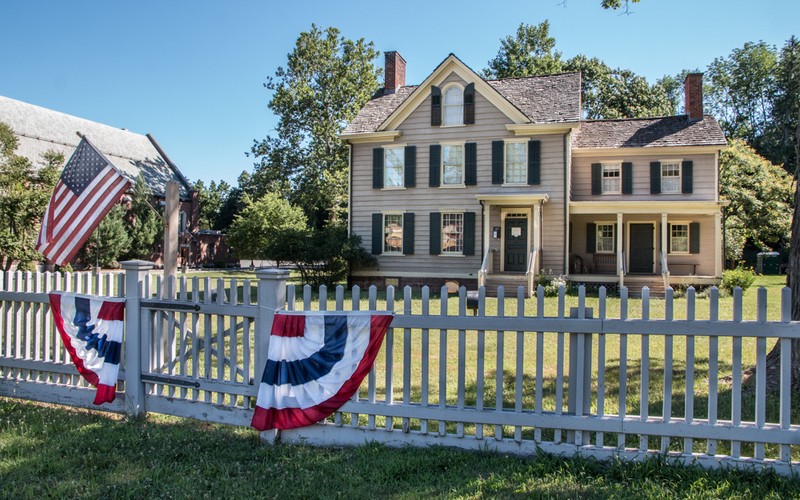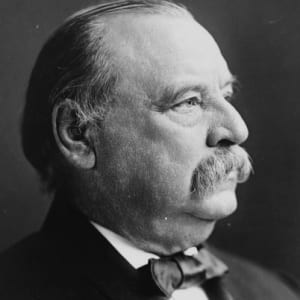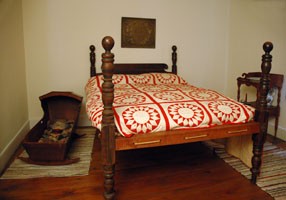Grover Cleveland Birthplace
Introduction
Text-to-speech Audio
Images
Grover Cleveland Birthplace

Grover Cleveland (1837-1908)

The room where Grover Cleveland was born, recreated to look as it did in 1837

Backstory and Context
Text-to-speech Audio
Stephen Grover Cleveland was born in this house in Caldwell, New Jersey on March 18, 1837. He was one of nine children born to Richard Falley Cleveland, a Presbyterian minister, and Ann (Neal) Cleveland. In 1841, the family moved to Fayetteville, New York. At the age of thirteen, Cleveland’s father fell ill, forcing him to drop out of school and begin working to support the family. A few years later, his father died. Sometime in the 1850s, Cleveland began working as a clerk at a law firm in Buffalo, where, in his spare time, he read law. In 1859, he was admitted to the bar. During the Civil War, Cleveland was drafted, but hired a substitute so that he could stay behind and care for his widowed mother. Through hard work and determination, he rose to prominence in the buffalo legal community and became assistant district attorney of Erie County in 1863. Seven years later, Cleveland became the county’s sheriff. He would serve in the position until 1873.
In 1881, Cleveland received the Democratic Party’s nomination for mayor of Buffalo. He won the race handily. As mayor, Cleveland earned a reputation as an opponent of corruption and wasteful spending. Only a year after winning Buffalo’s mayoral election, and despite being not well-known outside of Erie County, he secured the nomination of his political party for governor of New York. This race, too, he won easily. Two years later, in 1884, Cleveland won the Democratic Party’s nomination for president. In a very close election, he defeated Republican candidate James G. Blaine. With his victory, Cleveland became the first Democratic to win a presidential election since before the Civil War.
While in the White House, Cleveland built on his record of fighting corruption and wasteful spending. He vetoed fraudulent Civil War pension bills and investigated the western land claims of railroad companies. He also signed the Interstate Commerce Act and called for a lowering of tariffs. In 1886, Cleveland married twenty-one-year-old Frances Folsom. She was twenty-seven years his junior. To this day, he is the only president to have been married in the White House. Two years later, Cleveland ran for reelection. Despite winning the popular vote, he lost to his Republican challenger Benjamin Harrison in the Electoral College tally.
After his defeat to Harrison, Cleveland went to work at a prestigious law firm in New York City. He, however, would not stay out of the national political spotlight for long. In 1892, Cleveland secured the Democratic Party’s nomination for president. In a rematch with Harrison, he won handily. With his victory, he became the only U.S. president to serve two non-consecutive terms.
The economy dominated Cleveland’s second term. In 1893, the United States suffered the most severe economic downturn in its history to that point. Cleveland’s inability to solve the economic crisis, coupled with his refusal to provide direct aid to suffering Americans, caused his popularity to plummet. In 1896, with Cleveland eligible to run for reelection, the Democratic Party snubbed the sitting president by nominating William Jennings Bryan instead. After leaving the White House in 1897, Cleveland retired to Princeton, New Jersey, where he lectured and served as a trustee of Princeton University. On June 24, 1908, he died at the age of seventy-one. His remains were buried in Princeton Cemetery.
The house of Cleveland’s birth was a simple two-story structure built by First Presbyterian Church of Caldwell as its manse, or pastor’s residence, in 1832. Two years later, after accepting his assignment, Reverend Richard Falley Cleveland moved in with his growing family. The Cleveland family would remain in the house until 1841, when they moved to Fayetteville, New York. During the mid-nineteenth century, First Presbyterian Church of Caldwell added on to the house several times. In 1913, the house first opened its doors to the public. Two decades later, in 1934, the State of New Jersey purchased the building from the Cleveland Birthplace Memorial Association. In the 1970s, it was listed on the New Jersey and National Register of Historic Places. Today, the house of Cleveland’s birth continues to operate as a historic house museum. Most of the first-floor rooms appear as they did in 1837, the year he was born.
Sources
Freidel, Frank and Hugh S. Sidey. The Presidents of the United States of America. Washington, DC: White House Historical Association, 2006.
"Grover Cleveland." Encyclopaedia Britannica. Web. 29 September 2020 <https://www.britannica.com/biography/Grover-Cleveland>.
"Grover Cleveland Birthplace." Discover our Shared Heritage Travel Itinerary: American Presidents. National Parks Service, U.S. Department of the Interior. Web. 29 September 2020 <https://www.nps.gov/nr/travel/presidents/grover_cleveland_birthplace.html>.
"History of the Birthplace." Grover Cleveland Birthplace Memorial Association. Web. 29 September 2020 <http://presidentcleveland.org/grover-clevelands-birthplace/>.
Courtesy: Janet Markman <http://presidentcleveland.org>
https://www.biography.com/us-president/grover-cleveland
https://www.nps.gov/nr/travel/presidents/grover_cleveland_birthplace.html
